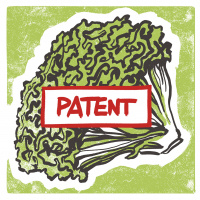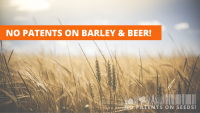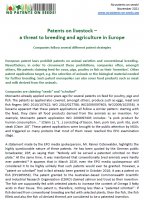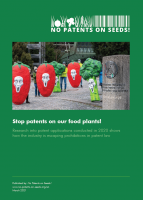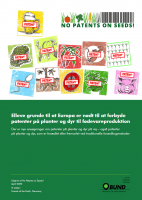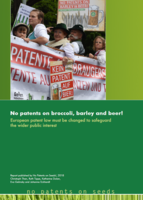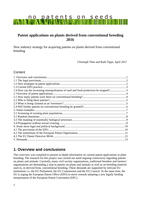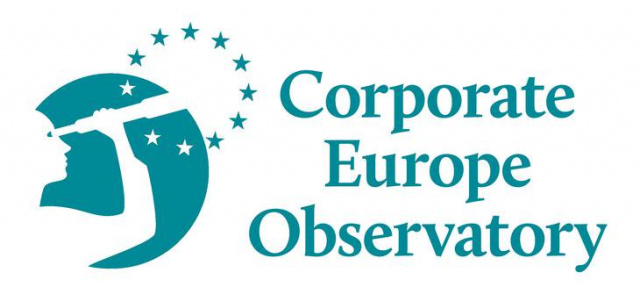Publications
Recent research conducted by No Patents on Seeds! revealed that the European Patent Office (EPO) granted
about 40 patents claiming conventional breeding between January and November 2025.
December 2025
Patents granted by the European Patent Office put pressure on politics
Research report, October 2025
Preliminary report, March 2025
Research from No Patents on Seeds! shows that in 2024 the European Patent Office (EPO) has granted a record number of patents on classical plant breeding. More than 40 patents can be identified that concern food plants not obtained from genetic engineering processes, doubling the number from recent years. Most of these patents are claiming plants with improved tolerance or resistance to plant pathogens such as viruses and fungal diseases.
Christoph Then (No Patents on Seeds!) - Short comment on the expert opinion:
“Legal options for changing the patent protection of plants in Germany, Europe and international law - Expert opinion commissioned by the Bundestagsfraktion Bündnis 90 /Die Grünen”
Analysis of the problem, case studies and potential solutions
Research report October 2024
New NO PATENTS ON SEEDS! research into international patent applications published in 2023 shows how CRISPR/Cas technology and new genetic engineering (NGTs) are being used to extend patent protection to conventionally-bred plants.
June 2024
Research carried out by No Patents on Seeds! shows how CRISPR/Cas technology is being used to undermine the freedom to operate for conventional tomato breeders. It was found, in particular, that patents are having a detrimental effect on conventional breeding efforts to produce tomatoes resistant to the Tomato Brown Rugose Fruit Virus. The plant pathogen was first described in 2015 in Jordan and Israel and it has been spreading rapidly ever since. It mostly affects tomato and pepper plants and takes its name from the wrinkly spots (rugose) that appear on the fruits.
April 2024
The European Patent Office (EPO) has scheduled a hearing for 7 February on an opposition filed by No Patents on Seeds! against a patent granted on conventionally-bred lettuce (EP2966992). This backgrounder has been compiled to provide information on the patent being opposed; it also provides an overview of other patent applications filed for conventionally-bred lettuce. It also discusses options for licencing contracts.
February 2024
Current interpretation of patent law is insufficient to stop patents on conventional breeding
Final version of the report, July 2023
This report gives a detailed interpretation of the new Rule 28 (2) of the Implementing Regulation of the European Patent Convention adopted in 2017 in the context of the EU patent directive 98/44
March 2023
KWS is filing increasing numbers of patents on conventionally-bred plants and plant genes
Report No Patents on Seeds!, December 2022
Patent research conducted in 2021 shows how industry is trying to patent genes, plants, seeds and food (Report June 2022)
Find the report and the French / Spanish / German summary here
March 2022
Overview of patent applications filed for conventionally-bred barley up until the end of 2021
November 2021
Patents on lifestock - a threat to breeding and agriculture in Europe
October 2021
Research into patent applications conducted in 2020 shows how the industry is escaping prohibitions in patent law.
New applications for patents on conventional plant and animal breeding (2020)
The report gives an overview of patent applications filed for conventional plant and animal breeding between
2018 and 2019, which may be granted by the European Patent Office in the next few years.
Der er nye ansøgninger om patenter på planter og dyr på vej – også patenter
på planter og dyr, som er forædlet eller fremavlet ved traditionelle forædlingsmetoder (2020)
Denne rapport giver et indblik i de patentansøgninger, der er indgivet på traditionelt forædlede planter og dyr i
2018 og 2019 og som måske vil blive godkendt af den Europæiske Patent Organisation i løbet af de næste par år.
Résumé en français du rapport "Eleven reasons why Europe needs to ban patents on food plants and farm animals. New applications for patents on conventional plant and animal breeding" (2020)
Overview 2018-2019: No patents on seeds! End the legal chaos at the European Patent Office! Conventional breeding must be free of patent claims.
Stop det juridiske kaos i den Europæiske Patent Organisation!Traditionel planteforædling skal friholdes fra patentering.
Patent applications covering everything from the animal feed to the final product are increasing.
Overview of patents on animals and animal breeding, which have been granted by the EPO during the last years.
In January 2018, NO PATENTS ON SEEDS! issued a new report which shows that the European Patent Office continues to grant patents on conventionally bred plants - despite the fact that in 2017, the contracting states had tried to tighten the relevant bans.
The report, published in 2016, provides an overview of recent developments concerning patents on conventionally bred plants - i.a. on new strategies of the industry and the European Patent Office, current patent applications and their political and legal background.







